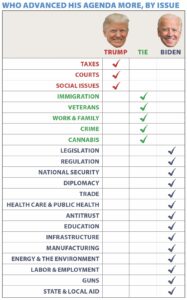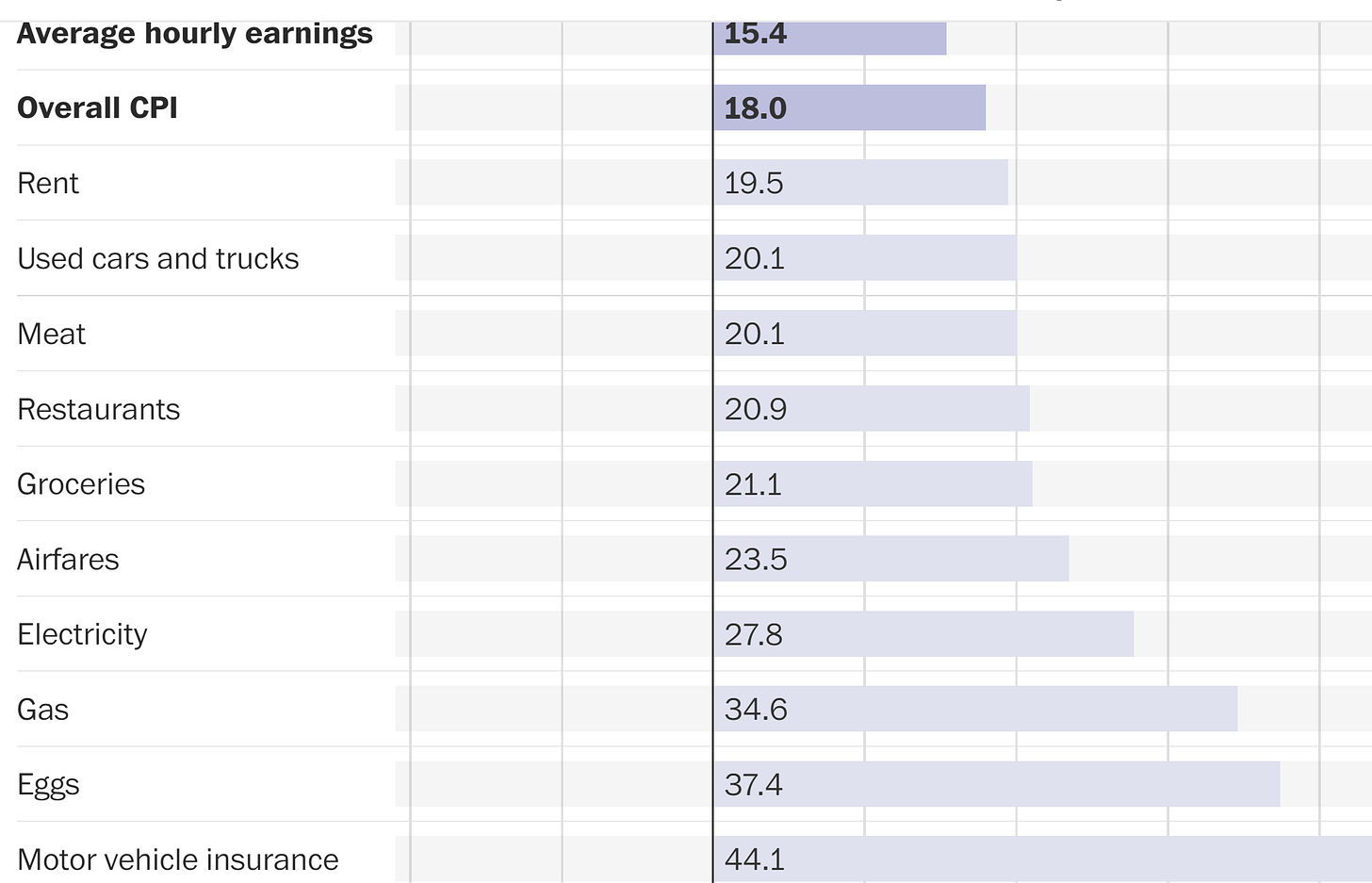A perennial strategic topic has popped up a lot recently, so I addressed it at New York:
In 2020, Joe Biden won four states by a margin of less than 2 percent of the vote: Georgia (0.23 percent), Arizona (0.30 percent), Wisconsin (0.63 percent), and Pennsylvania (1.33 percent). Donald Trump won one state, North Carolina, by 1.34 percent. Biden carried two other key states by margins under three points: Nevada (2.39 percent) and Michigan (2.78 percent). These seven states represent what most strategists in both parties consider to be the Biden-Trump battlegrounds for 2024, though obviously some will argue that others should be targeted (many Republicans think they have a chance in Minnesota, which Biden carried by just over 7 percent, and an abortion referendum makes Florida, which Trump carried by 4.36 percent, tempting for Democrats). Polling tends to confirm these seven as highly competitive this year.
2024 polls also, however, show a distinct regional pattern whereby Trump is leading Biden by robust margins in the Sun Belt states of Arizona (4.5 percent in the RCP polling averages), Nevada (3.2 percent), Georgia (3.8 percent), and North Carolina (4.6 percent), while Biden is doing relatively well in the Rust Belt states of Michigan (Trump leads by 2.8 percent, per RCP), Pennsylvania (Biden leads by 0.1 percent), and Wisconsin (Trump leads by 0.6 percent). His campaign may be tempted to narrowly focus on a Rust Belt strategy for victory but would be well advised to keep his options open.
There are some underlying dynamics that reinforce the regional pattern, as Ron Brownstein explains:
“President Joe Biden’s breakthrough 2020 wins in Arizona and Georgia seemed to confirm that the party’s future was increasingly reliant on Sun Belt states rapidly growing more racially diverse.
“But seven months before his rematch with presumptive GOP nominee Donald Trump, Biden’s most promising path may run directly through the three Rust Belt states that he recaptured in 2020 after Trump dislodged them from the ‘blue wall’ in 2016: Michigan, Pennsylvania and Wisconsin. That’s the conclusion of a broad array of Democratic strategists.
“The shift in expectations reflects the upside-down racial dynamics of the 2024 race, with most national and state polls showing Biden largely holding his 2020 support among White voters, while facing, at this point, unprecedented erosion among Black and Latino voters. Biden, as I wrote last year, is likewise maintaining his 2020 support better among older than younger voters. These surprising patterns have made the relatively older and Whiter three industrial blue wall states appear a better bet for Biden.”
If everything else stays the same as in 2020, Biden could lose Arizona, Nevada, and Georgia, along with North Carolina, and still win the presidency by the smallest possible margin in the Electoral College: 270 electoral votes to 268.
As Brownstein notes, the issue landscape in November could also make a Rust Belt strategy focused on white swing voters profitable:
“Biden is heavily stressing his support for legal abortion, and while polls show broad support for that position across racial lines, many pollsters believe it resonates most powerfully as a voting issue among college-educated White voters, especially women. Conversely, economic issues loom largest for most non-white voters; that’s a difficult dynamic for Biden across the Sun Belt because polls consistently show widespread discontent with his management of the economy, including among many Black and Latino voters.”
Another factor pushing Team Biden toward a Rust Belt strategy is the apparent strength of indie candidate Robert F. Kennedy Jr. among the Latino voters who are so prevalent in Arizona and Nevada, as Politico recently reported:
“[A] previously unreported poll in mid-February by Democratic group Equis Research … showed Kennedy performing surprisingly well among Latino voters in a dozen battleground states, effectively splintering Biden’s Hispanic coalition from 2020, when he garnered 59 percent Hispanic support …
“The poll of 2,010 registered Latino voters found Kennedy winning one in five young Latino voters, and also reported him capturing a sizable 17 percent Latino support in Arizona and an even more robust 21 percent in Nevada — the highest number among the battleground states polled.”
More generally, RFK Jr. seems to be taking votes away from Biden disproportionately in the Sun Belt. In the RCP averages, polls that include Kennedy and other minor candidates show Trump increasing his lead over Biden to 5.8 percent in Arizona, 5.5 percent in Nevada, 5.6 percent in Georgia, and 7 percent in North Carolina. These margins are pretty formidable.
Still, staking everything on sweeping Michigan, Pennsylvania, and Wisconsin would be perilous for Biden. Michigan still looks a bit shaky for the president thanks to Democratic base voters there who are unhappy with his position on the Israel-Hamas war. And you can argue that as November approaches, the Kennedy threat will fade as minor-party/indie candidacies typically do and that the Black and Latino voters so crucial in the Sun Belt are likely to return to the Democratic fold. In addition, Arizona and Nevada may have abortion-policy measures on the ballot in November that could help boost Democratic turnout. On Tuesday, Arizona’s high court reinstated a total abortion ban from 1864.
Fortunately for Biden, his campaign doesn’t have to commit to one region or the other just yet, and it has the resources to keep all the battleground states in play. But some Democrats may have a residual hangover from 2016, when Hillary Clinton vainly pursued Sun Belt votes while failing to shore up what was then called the “blue wall” of Rust Belt states that swung to Trump. The numbers indicate that Biden should indeed nail down Michigan, Pennsylvania, and Wisconsin if he can. But it would be prudent to make a big play for one of the larger Sun Belt states as well (e.g., Arizona, Georgia, or North Carolina) in case things go wrong. Having just one narrow path to 270 electoral votes is never a good idea.





